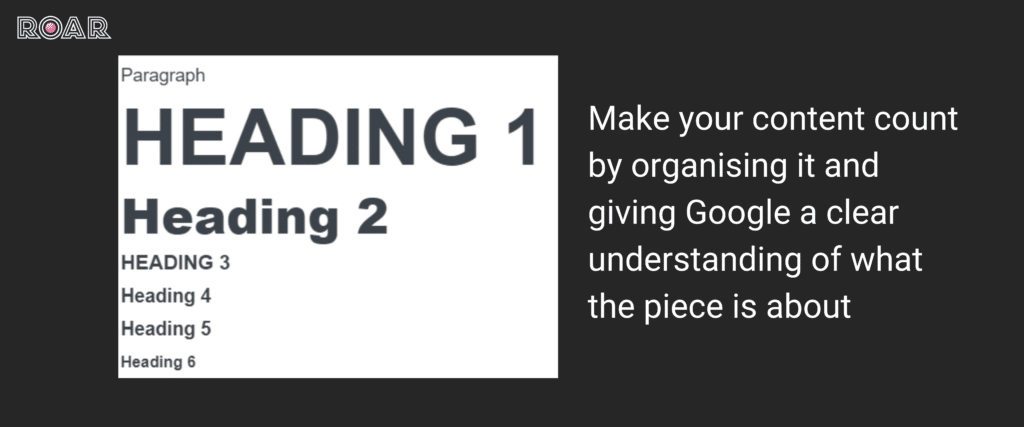
-
Oliver Eagle
- 6 Min Read
- Blog, SEO
How the Three Types of SEO Can Help Your Business
Breaking down the three types of SEO so you don’t have to, and more importantly, how they can help YOUR business.
When thinking of SEO (search engine optimisation), it’s easy to view it as a single component when that is not the case. There are three types of SEO that all do different things to help optimise your digital marketing efforts and deliver successful results. Combining the different forms of Search engine optimisation will help your business gain visibility by improving the SERP (Search engine results page’s) ranking and helping you get in front of the potential customers that matter at the right moment. Below are the three types of SEO methods that can improve your business ranking.
Technical SEO
I know what you’re thinking, technical SEO, what is it, and why should you bother?
Technical SEO is a crucial component is one of the three types of SEO and refers to everything that makes your business’ website easier for the search engine to crawl (search for your content) and then index (organised and store).
People LOVE fast websites, therefore, ensuring that your website has a good page load speed is important as it allows search engines to crawl and then index your website easily. Increasing the load speed of your website can be achieved through ‘minification’ which is removing the unnecessary comments and spacing in the source code. Although the code may be easier to read for humans with spaces between each block of code, the search engine finds it harder. Therefore, if you can make it easier for the computer to read your website, page speed will increase.
Another method to increase your page speed is compression, which can be performed on images, and other files, compressing down your images and files on your website is going to increase the speed they take to load, which will make your site more favourable to the search engine.
Want to know more about website page load time and how it can affect your business? Check out HubSpots blog on ‘11 Website Page Load Time Statistics‘ to find out more about website page load time and how it can affect your business, an important stat to consider for those online retailers out there, ‘Nearly 70% of consumers admit that page speed impacts their willingness to buy from an online retailer’.
On-Page SEO
On-Page SEO is another form of search engine optimization that makes up the three types of SEO, and if you’ve ever explored the vast landscape of SEO may be something you’re familiar with. This type of SEO is all about optimizing the content on the website to help improve the visibility on Google’s SERP (search engine results pages).
Good on-page SEO will help Google understand that the on-page content on your website is valuable and will help users find what they’re looking for. Ensuring the content on your website is of high quality is important as this is the core of your website, allowing both users and Google to know what you are all about! For example, an image on your website will make perfect sense to a user as they will be able to see what it is, however, a search engine requires something called Alt text, which is a small piece of text that the search engine uses to determine what the image is about. We recommend that you are specific and keep it below 125 characters, oh and no keyword stuffing! Use your keywords sparingly to avoid being ranked lower. Instead, we recommend you stick to the keyword density rule of 0.5-1%, for example, if you were to write a 600-word blog, to meet the 1% word density, you would try to include the chosen keyword six times through the content naturally.
Next, up is header tags, sounds simple right? Correct! Headers range from H1-6 (Header 1-6), and the purpose of header tags is to separate the headings and subheadings on a page. The headers rank in order of importance for SEO (search engine optimisation) in the following order:
Title Tag – Header 1 – Header 2 and so on…
These tags are not just for the design but also prop up the structure of the content, using multiple header one tags can result in the search engine getting confused about what content you are providing and, as a result, could penalise your website through ranking you lower in the SERP (search engine results page’s) and let’s face it no one wants that, so we recommend that you stick to using just one H1 tag to give Google and the user a clear understanding of what the piece is about.
Moving on, helping users and search engines to navigate around and find content on your website and using something called internal links will achieve precisely this, not using these links will make it harder for both the users and search engines to navigate across your website to your related and further amazing content!
Internal links come in different forms, internal links can feature on your homepage, post feed and even within your content. The internal links within your content, which are known as contextual links, serve as great tools to show your users content that may be related, as well as improve the website’s internal linking structure.
At ROAR, we recommend that when using internal links, ensure that they are relevant and provide value to the user and the search engine and establish a strong internal link structure. Let’s say you have a page on your website that contains valuable content, a great way to reinforce that value to the search engine is to have multiple internal links to that page featuring the content as the search engine identifies this and then believes it must be important, on the other hand, if your only links to your content are in your menu, this signals to the search engine that your content may not provide as much value to the user.
To utilise internal links to the fullest extent possible, we recommend you audit your website’s pages to identify where you can link them together. Want to know more about internal links? Go and check out ‘How to Use Internal Linking to Improve Your Website’s SEO’ by HubSpot.
Off-Page SEO
So, you’ve done both technical and on-page SEO, but you’re still having a hard time ranking on Google, this could be due to your poor off-page SEO, which entails everything outside of your website that still has an effect on your ranking, such as being active on social media and backlinks.
Essentially backlinks help to show confidence in your site from other websites, Google recognises this and is then favourable to your website and ranks it higher. Backlinks are one of the most important ranking factors that Google has and show users how your business is viewed and trusted by other businesses linking to your site, which is why they are so important when trying to rank highly. However, not all backlinks are deemed credible and of high quality, so stay away from using irrelevant, forced or outdated backlinks, as this could see your website penalised through a lower ranking, and instead lean towards better known, high-quality sites that generate good relevant, organic search traffic, for example, if your logistics company homepage gains a backlink from a post on “Home workouts” this would provide no relevance and may not be an effective backlink.
Sharing content on your social media is a great way to prove your authority and help improve SERP (search engine results page) rankings on Google. The search engine recognises when traffic is being directed from your social media platforms and thinks your website must have high-quality content from all the incoming traffic. This is why staying active on social media is important for off-page SEO as consistent engagement with your audience will help to increase your website’s shares and clicks and improve the domain authority. So what are you waiting for? Get posting! If you feel lost with social media, see our blog, ‘Creating Quality Social Media Assets‘.
To deep dive into off-page SEO, check out our blog to find out everything you need to know about off-page SEO
Google Business Profiles
Google Business Profile, previously known as ‘Google My Business’ or GMB, is a free tool to help you manage your business’s appearance on Google search and the maps. GMB can help to improve your local SEO, which can be powerful, especially for small businesses, as, after all, 46% of all Google searches are users looking for local information. Therefore it’s essential you optimise your business for local search, including key business service info, and encourage your customers to share reviews online, these are just two ways to improve your local SEO. Google is favourable to relevant local businesses and often rewards the best optimised relevant result to a search with the knowledge panel space in the search results. Don’t understand? Our blog on GMB services can help you gain a deeper understanding of GMB.
Looking to improve your online performance? Get a free SEO audit for your website Now!






